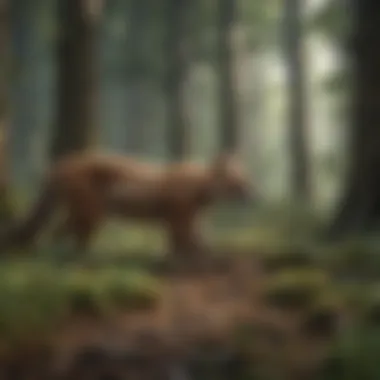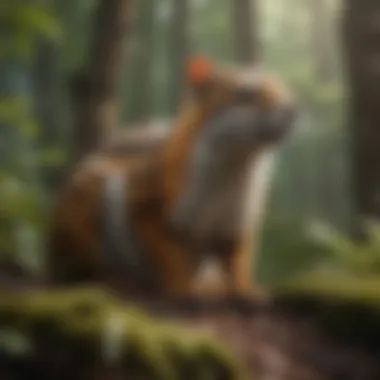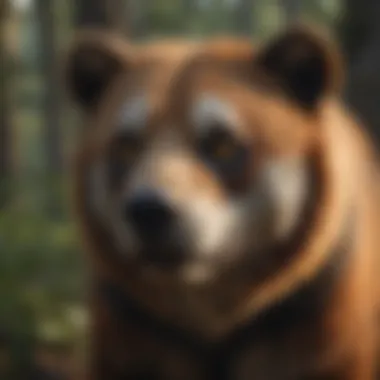Unveiling the Impact of Invasive Species on Forest Ecosystems


Overview of the Topic
Current Status and Challenges
The current status of forests overrun by invasive species depicts a grim picture. Native species are struggling to survive, facing fierce competition and displacement by invasives. The challenges posed by these intruders are multifold, ranging from altered fire regimes to disruptions in nutrient cycles, impacting the entire forest ecosystem.
Sustainable Solutions
In the battle against invasive species, sustainable solutions offer a beacon of hope. Implementing integrated pest management techniques can help control invasives without causing harm to the environment. Additionally, promoting native species planting and restoring natural habitats can aid in restoring balance and resilience to forest ecosystems.
Impact and Importance
The impact of invasive species on forests reverberates through ecosystems, affecting not only plant and animal species but also human communities reliant on these forests for resources. The importance of conservation efforts cannot be understated, as the survival of future generations is intrinsically linked to the preservation of biodiverse and healthy forest ecosystems.
Introduction
Defining Invasive Species
Invasive species refer to non-native organisms introduced to ecosystems, whose proliferation negatively impacts native flora and fauna. These species have the ability to outcompete indigenous plants and animals, disrupting the natural dynamics of the ecosystem. Understanding the characteristics that define invasive species is fundamental to devising effective management strategies and safeguarding biodiversity.
Significance of Forest Ecosystems
The significance of forest ecosystems lies in their role as the lungs of our planet, playing a crucial part in carbon sequestration and oxygen production. Additionally, forests harbor a wealth of biodiversity, supporting countless species and providing essential ecosystem services. Thus, the invasion of non-native species poses a significant threat to the intricate web of life within forests, jeopardizing their stability and function.
Purpose of the Article


The primary purpose of this article is to elucidate the detrimental impact of invasive species on forest ecosystems. By highlighting the disruptive potential of these intruders, we aim to underscore the importance of proactive conservation measures. Through a comprehensive exploration of the challenges posed by invasive species and the urgency to address them, this article calls for concerted efforts to mitigate their adverse effects.
Understanding Invasive Species
Understanding invasive species is pivotal in grasping the intricate dynamics of forest ecosystems. By examining the introduction and proliferation of non-native species, we unravel the profound disruptions they impose on the delicate ecological balance. Through an in-depth analysis of the characteristics of invasive species, we uncover their resilience and ability to outcompete indigenous flora and fauna, thereby threatening the very essence of biodiversity. This section delves into the intricacies of invasive species, shedding light on their pervasive nature and the challenges they pose to conservation efforts.
Characteristics of Invasive Species
Invasive species exhibit remarkable adaptability and reproductive prowess, enabling them to establish dominance over native species. They possess unique traits such as rapid growth, high reproductive rates, and lack of natural predators in their new habitat. These characteristics facilitate their rapid spread and colonization of diverse ecosystems, outcompeting indigenous organisms for vital resources. Understanding these traits is imperative in devising effective strategies to curb their proliferation and mitigate their adverse effects on forest ecosystems.
Modes of Introduction to Forests
Invasive species infiltrate forests through various pathways, including unintentional transport by humans, intentional introduction for ornamental or agricultural purposes, and natural dispersal mechanisms. Human activities such as global trade and travel play a significant role in the inadvertent introduction of invasive species to new environments. Once introduced, these species exploit gaps in the ecosystem, quickly establishing themselves and outcompeting native flora and fauna. Exploring the modes of introduction provides valuable insight into preventing and managing the impact of invasive species on forest ecosystems.
Ecological Impacts on Native Flora and Fauna
The arrival of invasive species often results in profound ecological repercussions for native flora and fauna. Competition for resources, predation, and habitat alteration are among the detrimental effects imposed by invasive species, leading to decline or extinction of indigenous species. Disruption of intricate ecological interactions can trigger cascading effects throughout the ecosystem, affecting biodiversity and ecosystem stability. Understanding these ecological impacts is crucial in formulating conservation strategies to safeguard forest ecosystems from the threats imposed by invasive species.
Spread of Invasive Species
In this segment of the article, we delve into the pivotal topic of the spread of invasive species within forest ecosystems. Understanding how invasive species spread is crucial as it sheds light on the mechanisms through which these non-native organisms establish themselves and proliferate in new environments. By comprehending the spread of invasive species, conservationists, students, and environmentalists can better grasp the magnitude of the challenges posed by these intruders into natural habitats.
Factors Facilitating Spread
The factors that facilitate the spread of invasive species play a significant role in determining the success and impact of these organisms within forest ecosystems. One key factor is the absence of natural predators or controls that would normally regulate the population of a species in its native habitat. Invasive species, when introduced to a new environment, can experience explosive population growth in the absence of these checks and balances, allowing them to rapidly colonize and outcompete native flora and fauna.


Moreover, the adaptability and resilience of invasive species contribute to their successful spread. These organisms often possess traits that enable them to thrive in diverse conditions, outcompeting native species for resources such as sunlight, water, and nutrients. Their rapid growth rates and ability to reproduce quickly further enhance their spread, creating challenges for local ecosystems trying to maintain their natural balance.
Challenges in Containment
The containment of invasive species presents a complex and multifaceted challenge for conservationists and environmentalists. Once invasive species have established a foothold in a forest ecosystem, eradicating or controlling their populations can be extremely difficult. These species often have robust reproductive systems and can reproduce at a much faster rate than native species, making it challenging to curb their numbers effectively.
Additionally, the interconnectedness of ecosystems can complicate containment efforts. Invasive species can impact not only the flora and fauna directly surrounding them but also create ripple effects throughout the ecosystem. For example, a non-native plant species that outcompetes native vegetation can alter food sources for animals, disrupt nutrient cycles, and even change soil composition, leading to cascading effects on ecosystem dynamics.
Global Implications
The spread of invasive species in forest ecosystems carries profound global implications that extend beyond local environmental concerns. In an increasingly interconnected world, invasive species can be easily transported across continents through trade, travel, and human activities. As a result, the impacts of invasive species transcend borders, posing challenges that require international collaboration and cooperation.
Moreover, the economic consequences of invasive species cannot be understated. These organisms can cause significant damage to agriculture, forestry, and infrastructure, leading to substantial financial costs for governments and industries worldwide. By understanding the global implications of invasive species spread, stakeholders can advocate for policies and practices that prioritize prevention and mitigation strategies on a broader scale.
Impact on Forest Biodiversity
In the realm of forest ecosystems, the impact of invasive species looms large, presenting a multifaceted challenge that reverberates through the intricate web of biodiversity. The overarching importance of this topic within the broader discussion of invasive species lies in its role as a destabilizing force, capable of unraveling the delicate balance that sustains forest ecosystems. By delving into the specifics of how invasive species can jeopardize the biodiversity of a given habitat, we gain valuable insights into the far-reaching consequences of unchecked invasion.
Threat to Endemic Species
The threat posed by invasive species to endemic flora and fauna represents a stark reality in the realm of conservation biology. Endemic species, uniquely adapted to their native ecosystems, face a precarious future when confronted with the relentless encroachment of non-native invaders. The gradual displacement and competition for resources that ensue as invasive species proliferate can spell doom for these specialized organisms, leading to a loss of genetic diversity and ecological stability.
Disruption of Ecosystem Services
Ecosystem services form the bedrock of ecological functionality, providing invaluable benefits to both wildlife and human populations. In the context of invasive species, the disruption of these essential services casts a shadow over the intricate tapestry of interactions within forest ecosystems. From pollination and seed dispersal to nutrient cycling and pest control, the ripple effects of invasive species can significantly degrade the quality of ecosystem services, perpetuating a cycle of ecological imbalance and decline.


Long-Term Consequences
Looking beyond the immediate impacts of invasive species on forest biodiversity, we uncover a narrative of long-term consequences that stretch far into the future. The irreversible alterations to ecosystem dynamics, coupled with the diminished resilience of native species, set the stage for a protracted battle against the forces of biological homogenization. As we grapple with the prospect of a radically transformed landscape, plagued by invasive dominance and ecological fragility, the importance of addressing these long-term consequences becomes increasingly clear.
Management Strategies
In this section, we delve deeply into the crucial aspect of Management Strategies within the context of invasive species in forests. Understanding the significance of effective management is paramount in combating the encroachment of non-native species that threaten the delicate balance of forest ecosystems. By employing comprehensive and proactive approaches in managing invasive species, conservationists and researchers can mitigate the adverse impacts on biodiversity and ecosystem stability. Strategic planning, monitoring, and implementation of control measures are integral components of successful Management Strategies.
Preventive Measures
Preventive Measures play a pivotal role in curbing the introduction and establishment of invasive species in forest environments. By emphasizing early detection, stringent biosecurity protocols, and risk assessment procedures, forest management authorities can proactively prevent the spread of non-native species. Implementation of quarantine measures, public awareness campaigns, and strict regulations on importing plant species are fundamental preventive strategies in safeguarding forest ecosystems from invasive threats.
Control and Eradication Techniques
Control and Eradication Techniques are essential in addressing established invasive populations within forest habitats. Intensive methods such as targeted herbicidal applications, manual removal of invasive species, and biological control through natural predators are commonly employed techniques to restore the ecological balance. Integrated pest management practices, adaptive strategies, and ongoing research to enhance the efficacy of eradication methods are crucial in managing invasive populations efficiently.
Collaborative Conservation Efforts
Collaborative Conservation Efforts are central to fostering partnerships among various stakeholders, including government agencies, non-profit organizations, research institutions, and local communities. By aligning conservation goals, sharing resources and expertise, and coordinating conservation initiatives, collective efforts can enhance the effectiveness of combating invasive species. Collaboration strengthens monitoring programs, research endeavors, and on-ground conservation actions, promoting a unified approach towards safeguarding forest biodiversity and ecosystem resilience.
Conclusion
In comprehending the impact of invasive species in forests, it becomes evident that the topic of conclusion holds immense relevance. By synthesizing the detrimental effects discussed in preceding sections, the significance of addressing invasive species becomes all the more apparent. Understanding the urgency of implementing strategies to combat the spread of non-native species is crucial. From disrupting ecosystem services to threatening biodiversity, the consequences of inaction are dire. The conclusion serves as a pivotal point in emphasizing the necessity for immediate action to safeguard forest ecosystems. It highlights the interconnectedness of species within these ecosystems and the delicate balance that invasive species disrupt.
Urgency of Addressing Invasive Species
When considering the urgency of addressing invasive species, one must recognize the swift and severe impact these organisms have on native flora and fauna. The rapid proliferation of invasive species poses a significant threat to the delicate equilibrium of forest ecosystems. Immediate attention is necessary to prevent irreversible damage to biodiversity and ecosystem services. Failure to act promptly could result in permanent alteration of these ecosystems, leading to long-term consequences that are challenging to rectify. As such, proactive measures must be taken to curb the spread of invasive species and preserve the integrity of forest habitats.
Call to Action for Preservation
A compelling call to action for preservation is paramount in combating the menace of invasive species in forests. Conservationists and environmentalists must join forces to implement robust strategies that prioritize the protection of endemic species and restoration of affected ecosystems. By raising awareness about the detrimental effects of invasive species and advocating for sustainable conservation practices, individuals can contribute to the preservation of forest biodiversity. Collaboration among stakeholders is essential in ensuring the long-term sustainability of forest ecosystems. Taking action today is imperative to secure a greener tomorrow for generations to come.



